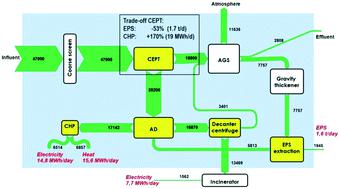当前位置:
X-MOL 学术
›
Environ. Sci.: Water Res. Technol.
›
论文详情
Our official English website, www.x-mol.net, welcomes your feedback! (Note: you will need to create a separate account there.)
Exploring resource recovery potentials for the aerobic granular sludge process by mass and energy balances – energy, biopolymer and phosphorous recovery from municipal wastewater
Environmental Science: Water Research & Technology ( IF 5 ) Pub Date : 2020-07-01 , DOI: 10.1039/d0ew00310g Philipp Kehrein 1, 2, 3 , Mark van Loosdrecht 1, 2, 3 , Patricia Osseweijer 1, 2, 3 , John Posada 1, 2, 3
Environmental Science: Water Research & Technology ( IF 5 ) Pub Date : 2020-07-01 , DOI: 10.1039/d0ew00310g Philipp Kehrein 1, 2, 3 , Mark van Loosdrecht 1, 2, 3 , Patricia Osseweijer 1, 2, 3 , John Posada 1, 2, 3
Affiliation

|
Municipal wastewater cannot any longer be perceived as a waste stream because it contains water, energy, fertilizer and other products that can be recovered with innovative technologies in so called ‘water resource factories’. Therefore a paradigm shift has been proclaimed to design water resource factories in the future that feed into a circular economy. The rapid development of new resource recovery technologies requires a solid analysis prior to their integration into treatment processes to understand more about their potential to contribute to more circular urban water management practices. Mass and energy balances are an excellent method to model resource recovery potentials of innovative processes at an early design stage because they allow quantifying recoverable resources as well as trade-offs between possible recovery technology choices. We modelled a real wastewater treatment plant which uses aerobic granular sludge treatment and is currently operated with no on-site resource recovery. Then, 5 different possible process designs that would recover chemical oxygen demand (COD) as energy and/or extracellular polymeric substances (EPS), and phosphorous (P) as struvite have been modelled. The integration of anaerobic digestion for subsequent electricity and heat generation from methane provides the possibility to recover on-site a rather small fraction of influent-COD as energy. But if this is combined with chemically enhanced primary treatment (CEPT), almost one third of the influent-COD may be recovered. Simultaneous energy and EPS recovery may lead to trade-offs as CEPT integration for maximum energy recovery may halve the EPS recovery potential but would increase the overall influent-COD recovery rate. Struvite fertilizer recovery integration may only recover a small fraction of influent-P and is therefore questionable when other P recovery options are possible that aim for higher recovery rates. The fertilizer recovery potential may be significantly decreased by EPS recovery since the latter contain P. This study helps to understand how aerobic granular sludge based treatment processes can be designed as water resource factories. Mass and energy balances can be conducted at a very early process design stage and results may be used to identify promising process designs for subsequent more in depth techno-economic or environmental impact assessments.
中文翻译:

通过质量和能量平衡-从市政废水中回收能源,生物聚合物和磷,探索好氧颗粒污泥工艺的资源回收潜力
市政废水不再被视为废物流,因为其中包含水,能源,肥料和其他产品,这些产品可以通过所谓的“水资源工厂”中的创新技术进行回收。因此,已经宣布了范式的转变,以设计将来可用于循环经济的水资源工厂。新资源回收技术的快速发展需要在将其整合到处理过程之前进行扎实的分析,以更多地了解其有助于更循环的城市水管理实践的潜力。质量和能量平衡是在早期设计阶段对创新过程的资源回收潜力进行建模的一种极好的方法,因为它们可以量化可回收资源以及在可能的回收技术选择之间进行权衡。我们对一个实际的废水处理厂进行了建模,该厂使用好氧颗粒污泥处理,目前没有现场资源回收。然后,对5种不同的可能的工艺设计进行了建模,这些设计将回收化学需氧量(COD)作为能量和/或细胞外聚合物质(EPS)和磷(P)作为鸟粪石。厌氧消化的集成,用于随后的甲烷发电和热能,提供了现场回收相当一部分进水COD作为能源的可能性。但是,如果将其与化学强化一级处理(CEPT)结合使用,则可以回收近三分之一的进水COD。能源和EPS的同时回收可能导致权衡取舍,因为最大能量回收的CEPT集成可能使EPS的回收潜力减半,但会增加进水COD的总体回收率。鸟粪石肥料的回收整合可能仅回收一小部分流入的磷,因此,当可能有其他旨在提高回收率的磷回收方案时,这是有问题的。由于EPS包含P,因此EPS回收后肥料的回收潜力可能会大大降低。这项研究有助于了解如何将基于好氧颗粒污泥的处理过程设计为水资源工厂。
更新日期:2020-07-31
中文翻译:

通过质量和能量平衡-从市政废水中回收能源,生物聚合物和磷,探索好氧颗粒污泥工艺的资源回收潜力
市政废水不再被视为废物流,因为其中包含水,能源,肥料和其他产品,这些产品可以通过所谓的“水资源工厂”中的创新技术进行回收。因此,已经宣布了范式的转变,以设计将来可用于循环经济的水资源工厂。新资源回收技术的快速发展需要在将其整合到处理过程之前进行扎实的分析,以更多地了解其有助于更循环的城市水管理实践的潜力。质量和能量平衡是在早期设计阶段对创新过程的资源回收潜力进行建模的一种极好的方法,因为它们可以量化可回收资源以及在可能的回收技术选择之间进行权衡。我们对一个实际的废水处理厂进行了建模,该厂使用好氧颗粒污泥处理,目前没有现场资源回收。然后,对5种不同的可能的工艺设计进行了建模,这些设计将回收化学需氧量(COD)作为能量和/或细胞外聚合物质(EPS)和磷(P)作为鸟粪石。厌氧消化的集成,用于随后的甲烷发电和热能,提供了现场回收相当一部分进水COD作为能源的可能性。但是,如果将其与化学强化一级处理(CEPT)结合使用,则可以回收近三分之一的进水COD。能源和EPS的同时回收可能导致权衡取舍,因为最大能量回收的CEPT集成可能使EPS的回收潜力减半,但会增加进水COD的总体回收率。鸟粪石肥料的回收整合可能仅回收一小部分流入的磷,因此,当可能有其他旨在提高回收率的磷回收方案时,这是有问题的。由于EPS包含P,因此EPS回收后肥料的回收潜力可能会大大降低。这项研究有助于了解如何将基于好氧颗粒污泥的处理过程设计为水资源工厂。



























 京公网安备 11010802027423号
京公网安备 11010802027423号